Innovation, Creativity, and Entrepreneurship Report: Amazon Case Study
VerifiedAdded on 2022/09/18
|14
|2799
|25
Report
AI Summary
This report examines the concepts of innovation, creativity, and entrepreneurship, using Amazon as a case study. It explores the significance of business model innovation, highlighting how Amazon revolutionized the retail industry through its e-commerce model, including the Kindle. The report analyzes how Amazon creates value through strategies like personalization, mobile technology integration, and low-cost pricing, leading to increased market value. It evaluates Amazon's competitive advantages, focusing on eliminating traditional distributors, creating infrastructure, reducing profitability for market share, and diversifying customer value propositions. The report also references the work of Kavadias et al. (2016) on transformative business models, and discusses how Amazon's strategies have allowed it to gain a competitive edge over its rivals.
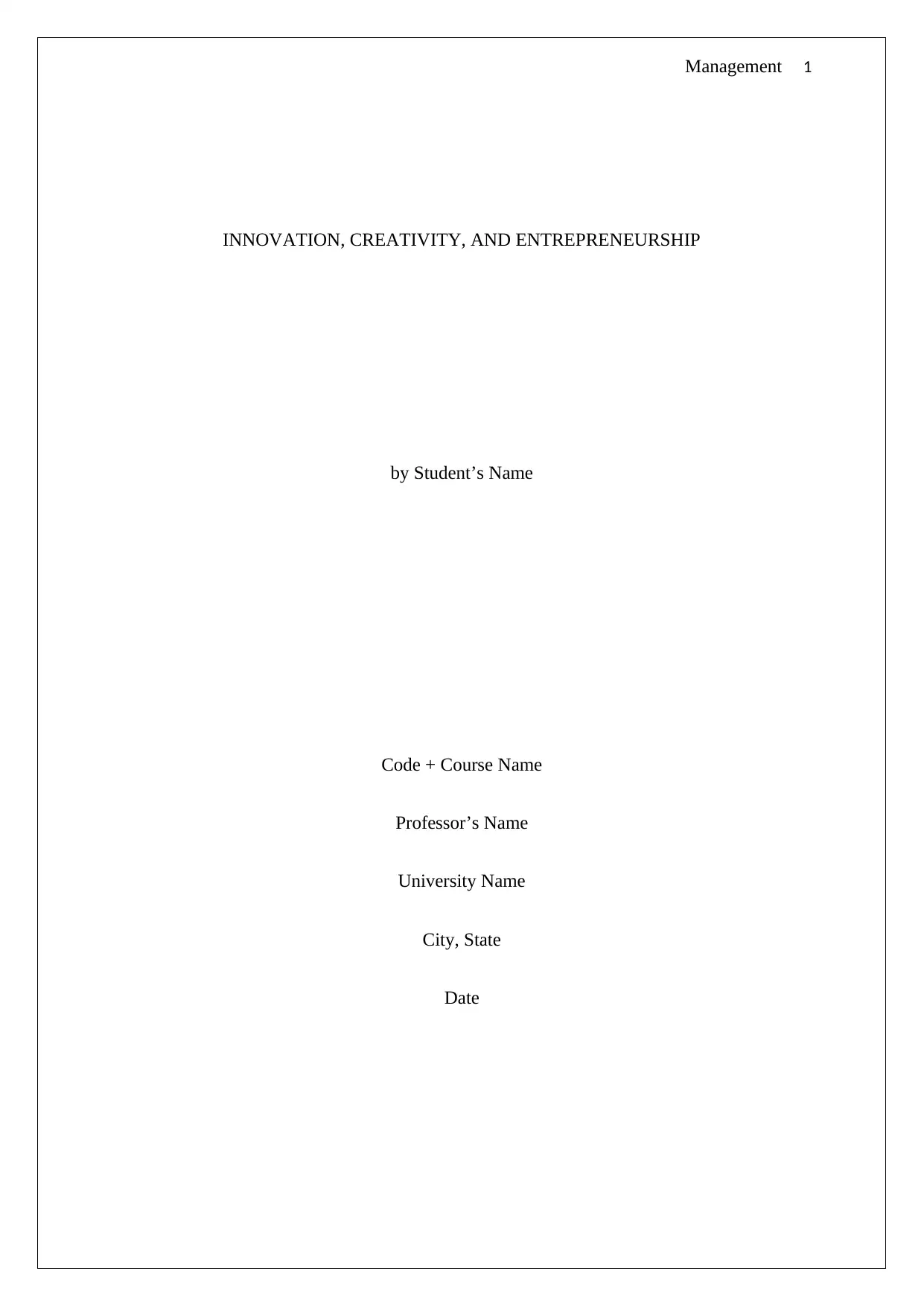
Management 1
INNOVATION, CREATIVITY, AND ENTREPRENEURSHIP
by Student’s Name
Code + Course Name
Professor’s Name
University Name
City, State
Date
INNOVATION, CREATIVITY, AND ENTREPRENEURSHIP
by Student’s Name
Code + Course Name
Professor’s Name
University Name
City, State
Date
Paraphrase This Document
Need a fresh take? Get an instant paraphrase of this document with our AI Paraphraser
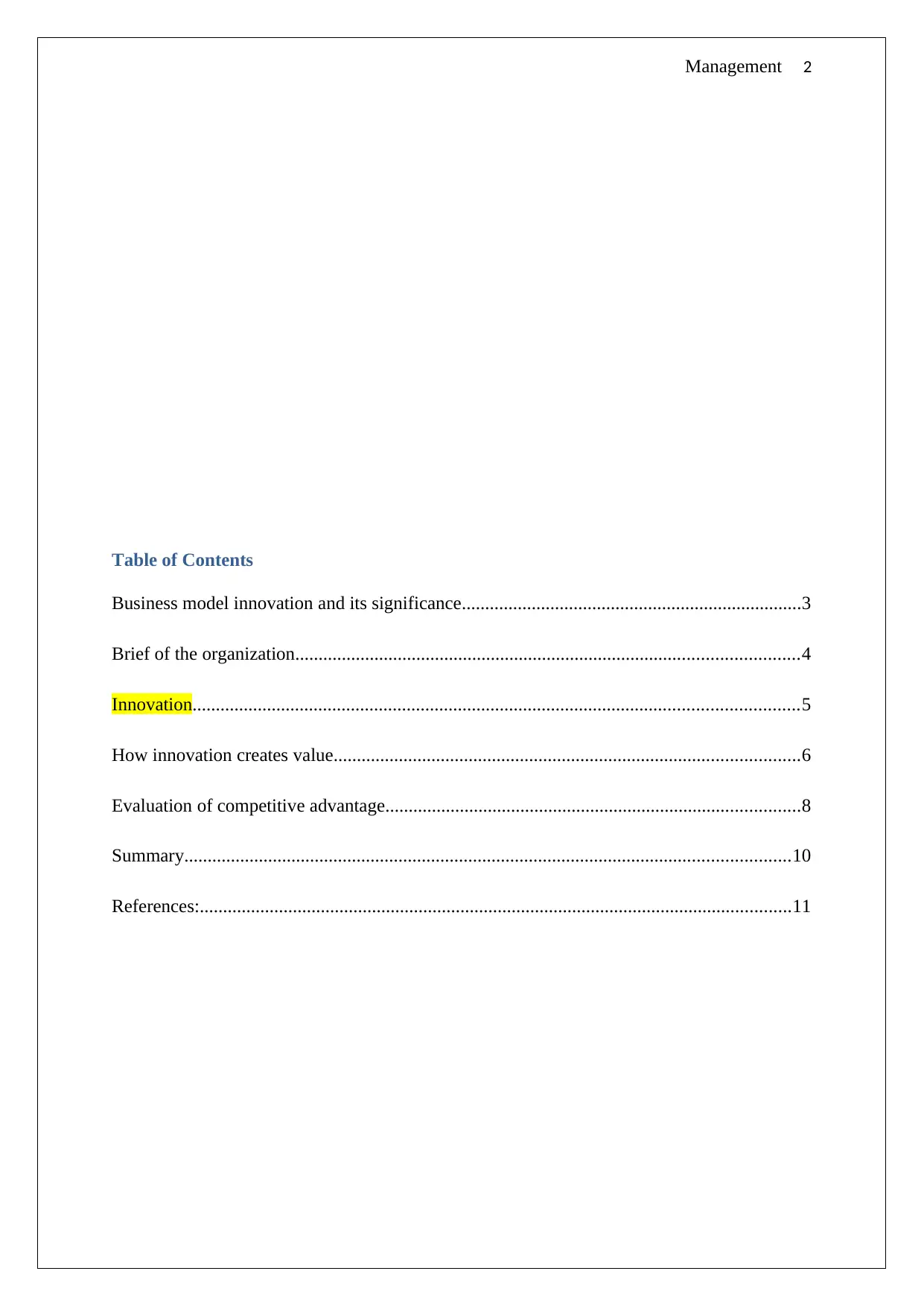
Management 2
Table of Contents
Business model innovation and its significance.........................................................................3
Brief of the organization............................................................................................................4
Innovation..................................................................................................................................5
How innovation creates value....................................................................................................6
Evaluation of competitive advantage.........................................................................................8
Summary..................................................................................................................................10
References:...............................................................................................................................11
Table of Contents
Business model innovation and its significance.........................................................................3
Brief of the organization............................................................................................................4
Innovation..................................................................................................................................5
How innovation creates value....................................................................................................6
Evaluation of competitive advantage.........................................................................................8
Summary..................................................................................................................................10
References:...............................................................................................................................11
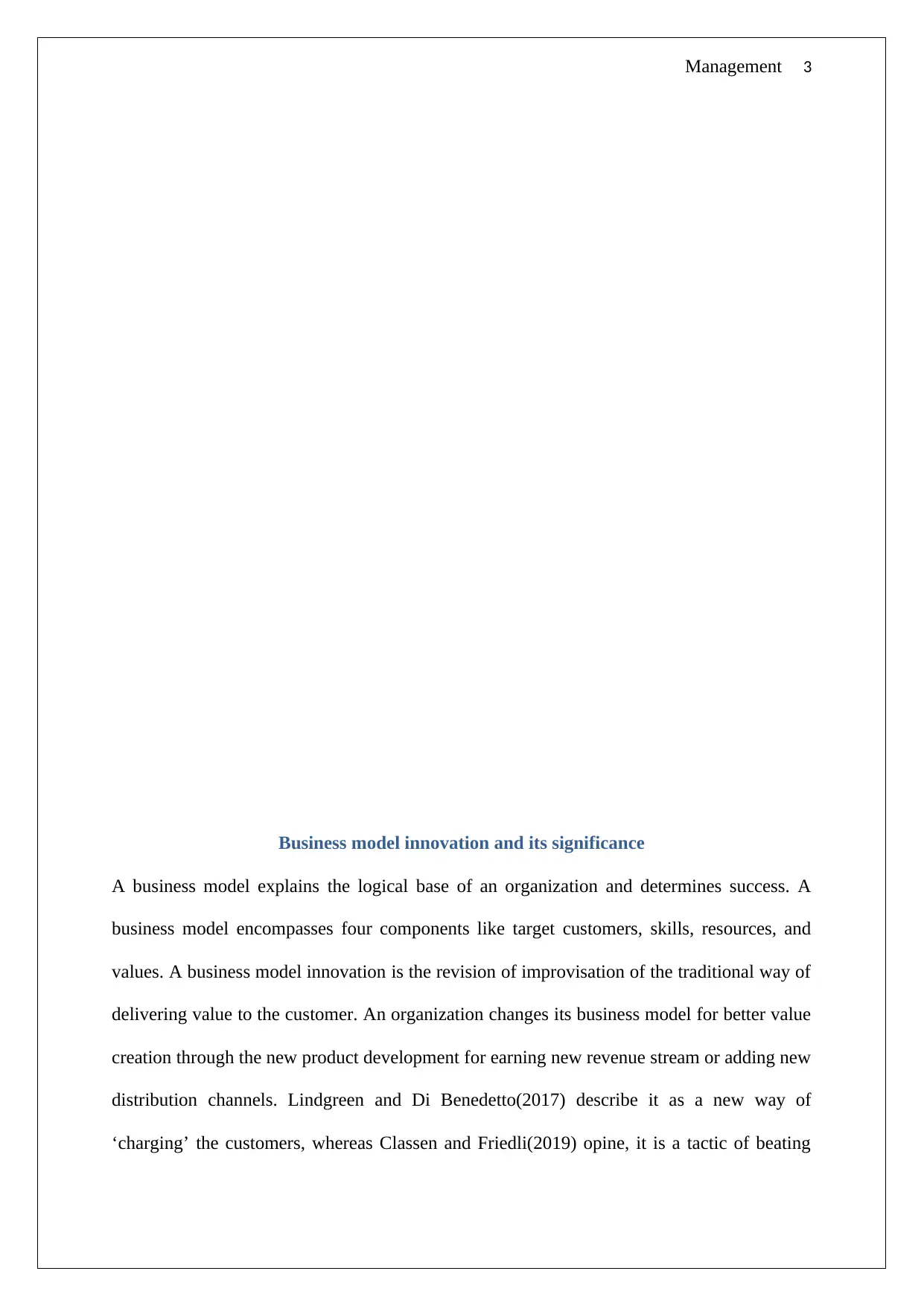
Management 3
Business model innovation and its significance
A business model explains the logical base of an organization and determines success. A
business model encompasses four components like target customers, skills, resources, and
values. A business model innovation is the revision of improvisation of the traditional way of
delivering value to the customer. An organization changes its business model for better value
creation through the new product development for earning new revenue stream or adding new
distribution channels. Lindgreen and Di Benedetto(2017) describe it as a new way of
‘charging’ the customers, whereas Classen and Friedli(2019) opine, it is a tactic of beating
Business model innovation and its significance
A business model explains the logical base of an organization and determines success. A
business model encompasses four components like target customers, skills, resources, and
values. A business model innovation is the revision of improvisation of the traditional way of
delivering value to the customer. An organization changes its business model for better value
creation through the new product development for earning new revenue stream or adding new
distribution channels. Lindgreen and Di Benedetto(2017) describe it as a new way of
‘charging’ the customers, whereas Classen and Friedli(2019) opine, it is a tactic of beating
⊘ This is a preview!⊘
Do you want full access?
Subscribe today to unlock all pages.

Trusted by 1+ million students worldwide
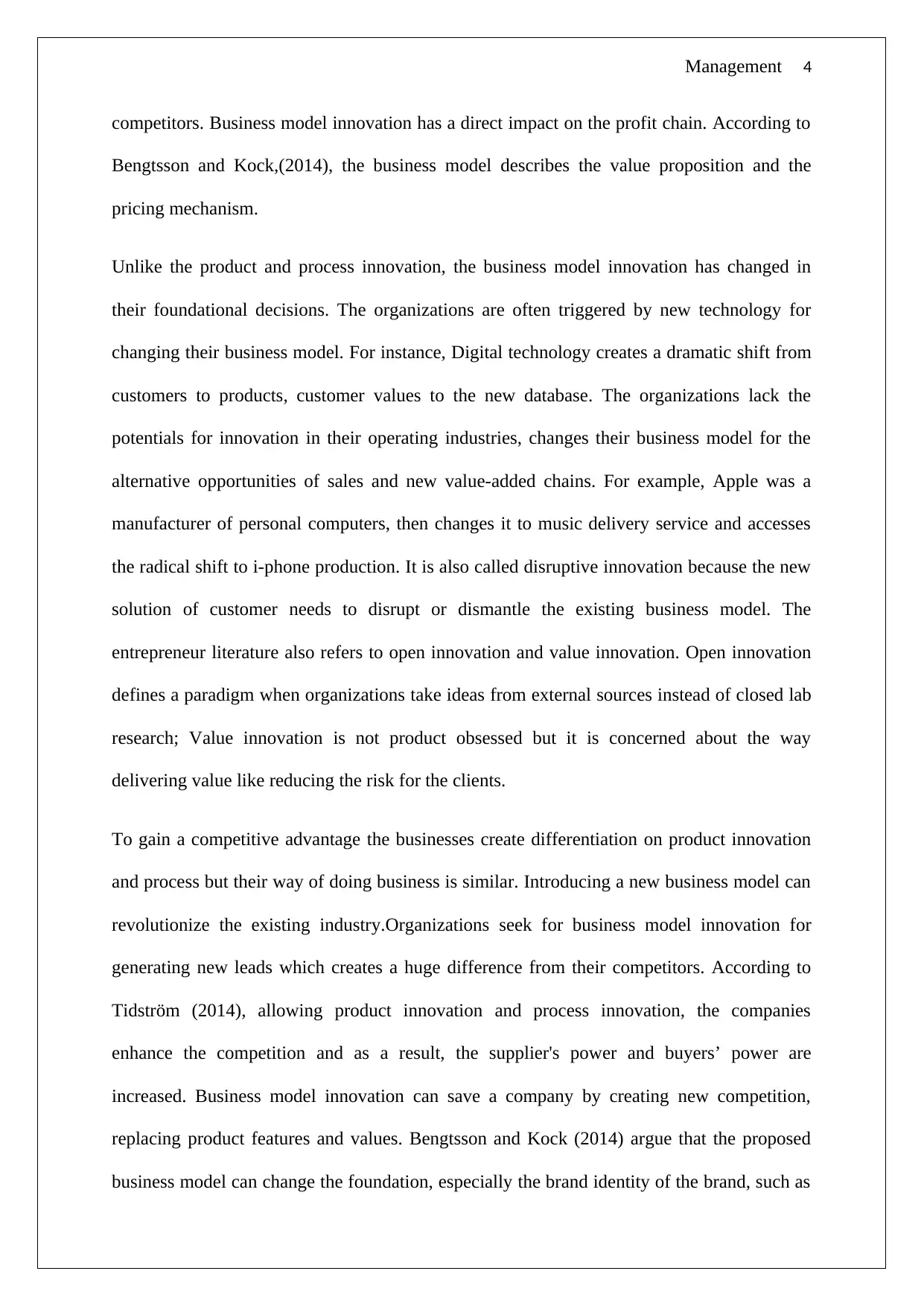
Management 4
competitors. Business model innovation has a direct impact on the profit chain. According to
Bengtsson and Kock,(2014), the business model describes the value proposition and the
pricing mechanism.
Unlike the product and process innovation, the business model innovation has changed in
their foundational decisions. The organizations are often triggered by new technology for
changing their business model. For instance, Digital technology creates a dramatic shift from
customers to products, customer values to the new database. The organizations lack the
potentials for innovation in their operating industries, changes their business model for the
alternative opportunities of sales and new value-added chains. For example, Apple was a
manufacturer of personal computers, then changes it to music delivery service and accesses
the radical shift to i-phone production. It is also called disruptive innovation because the new
solution of customer needs to disrupt or dismantle the existing business model. The
entrepreneur literature also refers to open innovation and value innovation. Open innovation
defines a paradigm when organizations take ideas from external sources instead of closed lab
research; Value innovation is not product obsessed but it is concerned about the way
delivering value like reducing the risk for the clients.
To gain a competitive advantage the businesses create differentiation on product innovation
and process but their way of doing business is similar. Introducing a new business model can
revolutionize the existing industry.Organizations seek for business model innovation for
generating new leads which creates a huge difference from their competitors. According to
Tidström (2014), allowing product innovation and process innovation, the companies
enhance the competition and as a result, the supplier's power and buyers’ power are
increased. Business model innovation can save a company by creating new competition,
replacing product features and values. Bengtsson and Kock (2014) argue that the proposed
business model can change the foundation, especially the brand identity of the brand, such as
competitors. Business model innovation has a direct impact on the profit chain. According to
Bengtsson and Kock,(2014), the business model describes the value proposition and the
pricing mechanism.
Unlike the product and process innovation, the business model innovation has changed in
their foundational decisions. The organizations are often triggered by new technology for
changing their business model. For instance, Digital technology creates a dramatic shift from
customers to products, customer values to the new database. The organizations lack the
potentials for innovation in their operating industries, changes their business model for the
alternative opportunities of sales and new value-added chains. For example, Apple was a
manufacturer of personal computers, then changes it to music delivery service and accesses
the radical shift to i-phone production. It is also called disruptive innovation because the new
solution of customer needs to disrupt or dismantle the existing business model. The
entrepreneur literature also refers to open innovation and value innovation. Open innovation
defines a paradigm when organizations take ideas from external sources instead of closed lab
research; Value innovation is not product obsessed but it is concerned about the way
delivering value like reducing the risk for the clients.
To gain a competitive advantage the businesses create differentiation on product innovation
and process but their way of doing business is similar. Introducing a new business model can
revolutionize the existing industry.Organizations seek for business model innovation for
generating new leads which creates a huge difference from their competitors. According to
Tidström (2014), allowing product innovation and process innovation, the companies
enhance the competition and as a result, the supplier's power and buyers’ power are
increased. Business model innovation can save a company by creating new competition,
replacing product features and values. Bengtsson and Kock (2014) argue that the proposed
business model can change the foundation, especially the brand identity of the brand, such as
Paraphrase This Document
Need a fresh take? Get an instant paraphrase of this document with our AI Paraphraser
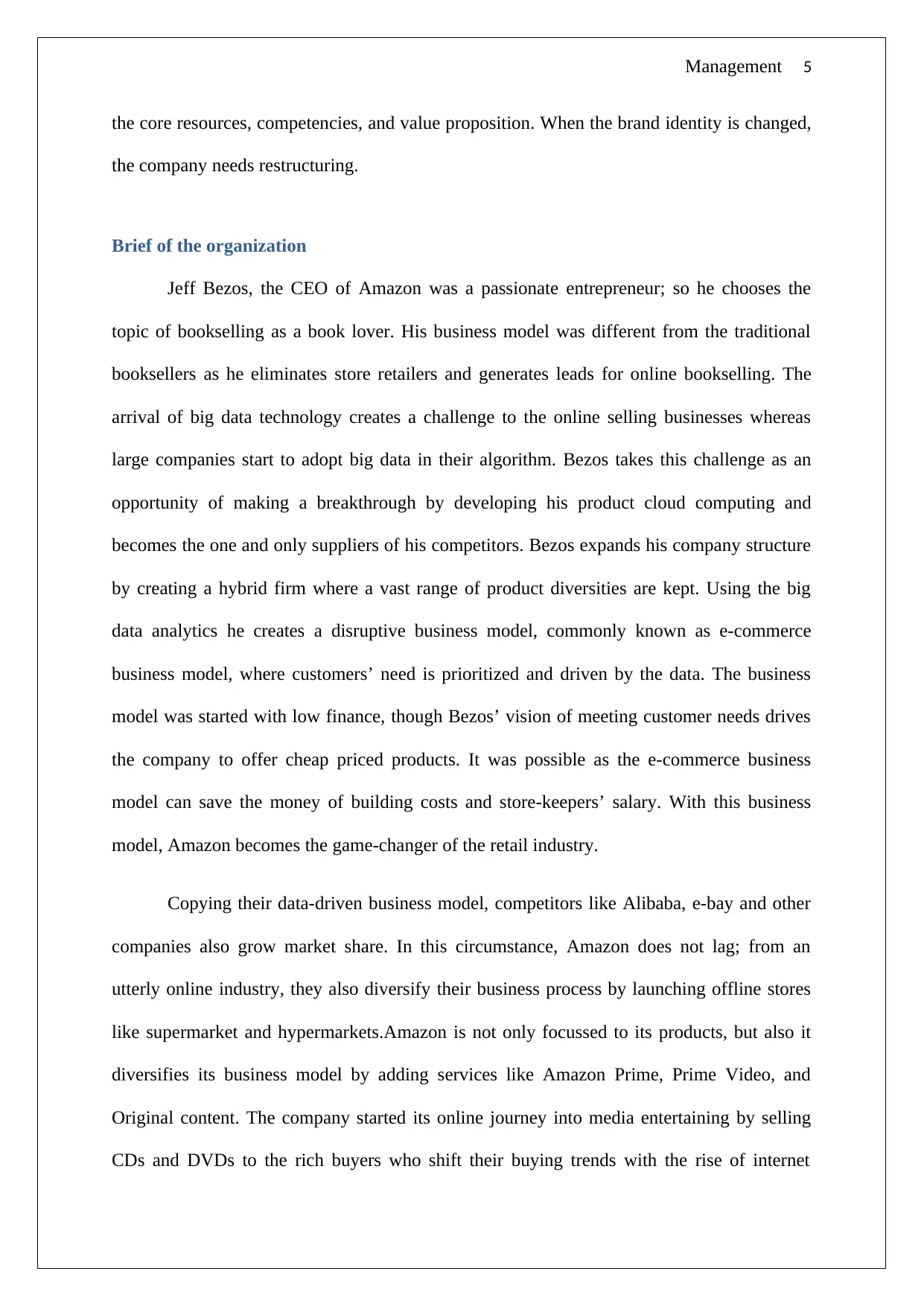
Management 5
the core resources, competencies, and value proposition. When the brand identity is changed,
the company needs restructuring.
Brief of the organization
Jeff Bezos, the CEO of Amazon was a passionate entrepreneur; so he chooses the
topic of bookselling as a book lover. His business model was different from the traditional
booksellers as he eliminates store retailers and generates leads for online bookselling. The
arrival of big data technology creates a challenge to the online selling businesses whereas
large companies start to adopt big data in their algorithm. Bezos takes this challenge as an
opportunity of making a breakthrough by developing his product cloud computing and
becomes the one and only suppliers of his competitors. Bezos expands his company structure
by creating a hybrid firm where a vast range of product diversities are kept. Using the big
data analytics he creates a disruptive business model, commonly known as e-commerce
business model, where customers’ need is prioritized and driven by the data. The business
model was started with low finance, though Bezos’ vision of meeting customer needs drives
the company to offer cheap priced products. It was possible as the e-commerce business
model can save the money of building costs and store-keepers’ salary. With this business
model, Amazon becomes the game-changer of the retail industry.
Copying their data-driven business model, competitors like Alibaba, e-bay and other
companies also grow market share. In this circumstance, Amazon does not lag; from an
utterly online industry, they also diversify their business process by launching offline stores
like supermarket and hypermarkets.Amazon is not only focussed to its products, but also it
diversifies its business model by adding services like Amazon Prime, Prime Video, and
Original content. The company started its online journey into media entertaining by selling
CDs and DVDs to the rich buyers who shift their buying trends with the rise of internet
the core resources, competencies, and value proposition. When the brand identity is changed,
the company needs restructuring.
Brief of the organization
Jeff Bezos, the CEO of Amazon was a passionate entrepreneur; so he chooses the
topic of bookselling as a book lover. His business model was different from the traditional
booksellers as he eliminates store retailers and generates leads for online bookselling. The
arrival of big data technology creates a challenge to the online selling businesses whereas
large companies start to adopt big data in their algorithm. Bezos takes this challenge as an
opportunity of making a breakthrough by developing his product cloud computing and
becomes the one and only suppliers of his competitors. Bezos expands his company structure
by creating a hybrid firm where a vast range of product diversities are kept. Using the big
data analytics he creates a disruptive business model, commonly known as e-commerce
business model, where customers’ need is prioritized and driven by the data. The business
model was started with low finance, though Bezos’ vision of meeting customer needs drives
the company to offer cheap priced products. It was possible as the e-commerce business
model can save the money of building costs and store-keepers’ salary. With this business
model, Amazon becomes the game-changer of the retail industry.
Copying their data-driven business model, competitors like Alibaba, e-bay and other
companies also grow market share. In this circumstance, Amazon does not lag; from an
utterly online industry, they also diversify their business process by launching offline stores
like supermarket and hypermarkets.Amazon is not only focussed to its products, but also it
diversifies its business model by adding services like Amazon Prime, Prime Video, and
Original content. The company started its online journey into media entertaining by selling
CDs and DVDs to the rich buyers who shift their buying trends with the rise of internet
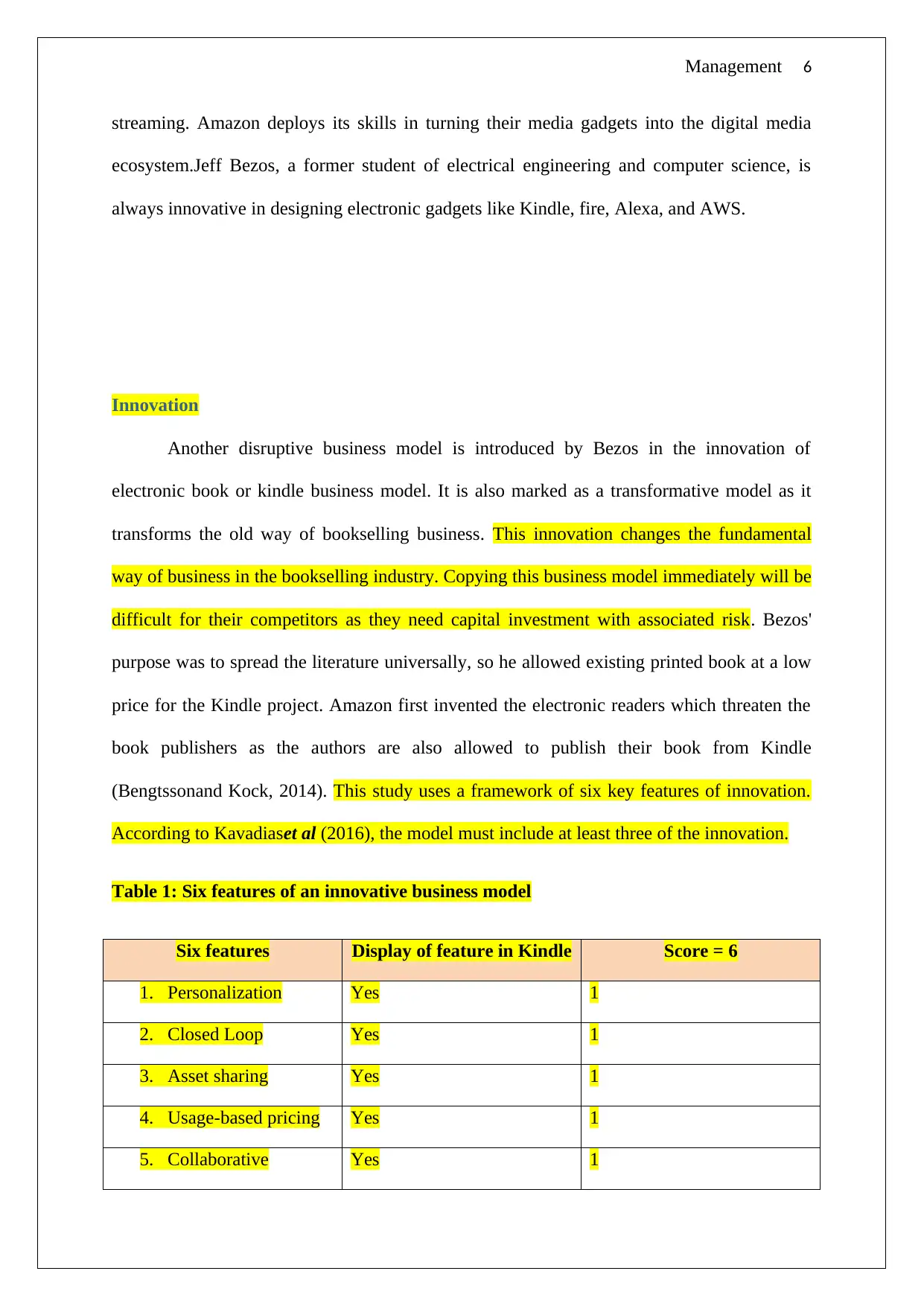
Management 6
streaming. Amazon deploys its skills in turning their media gadgets into the digital media
ecosystem.Jeff Bezos, a former student of electrical engineering and computer science, is
always innovative in designing electronic gadgets like Kindle, fire, Alexa, and AWS.
Innovation
Another disruptive business model is introduced by Bezos in the innovation of
electronic book or kindle business model. It is also marked as a transformative model as it
transforms the old way of bookselling business. This innovation changes the fundamental
way of business in the bookselling industry. Copying this business model immediately will be
difficult for their competitors as they need capital investment with associated risk. Bezos'
purpose was to spread the literature universally, so he allowed existing printed book at a low
price for the Kindle project. Amazon first invented the electronic readers which threaten the
book publishers as the authors are also allowed to publish their book from Kindle
(Bengtssonand Kock, 2014). This study uses a framework of six key features of innovation.
According to Kavadiaset al (2016), the model must include at least three of the innovation.
Table 1: Six features of an innovative business model
Six features Display of feature in Kindle Score = 6
1. Personalization Yes 1
2. Closed Loop Yes 1
3. Asset sharing Yes 1
4. Usage-based pricing Yes 1
5. Collaborative Yes 1
streaming. Amazon deploys its skills in turning their media gadgets into the digital media
ecosystem.Jeff Bezos, a former student of electrical engineering and computer science, is
always innovative in designing electronic gadgets like Kindle, fire, Alexa, and AWS.
Innovation
Another disruptive business model is introduced by Bezos in the innovation of
electronic book or kindle business model. It is also marked as a transformative model as it
transforms the old way of bookselling business. This innovation changes the fundamental
way of business in the bookselling industry. Copying this business model immediately will be
difficult for their competitors as they need capital investment with associated risk. Bezos'
purpose was to spread the literature universally, so he allowed existing printed book at a low
price for the Kindle project. Amazon first invented the electronic readers which threaten the
book publishers as the authors are also allowed to publish their book from Kindle
(Bengtssonand Kock, 2014). This study uses a framework of six key features of innovation.
According to Kavadiaset al (2016), the model must include at least three of the innovation.
Table 1: Six features of an innovative business model
Six features Display of feature in Kindle Score = 6
1. Personalization Yes 1
2. Closed Loop Yes 1
3. Asset sharing Yes 1
4. Usage-based pricing Yes 1
5. Collaborative Yes 1
⊘ This is a preview!⊘
Do you want full access?
Subscribe today to unlock all pages.

Trusted by 1+ million students worldwide
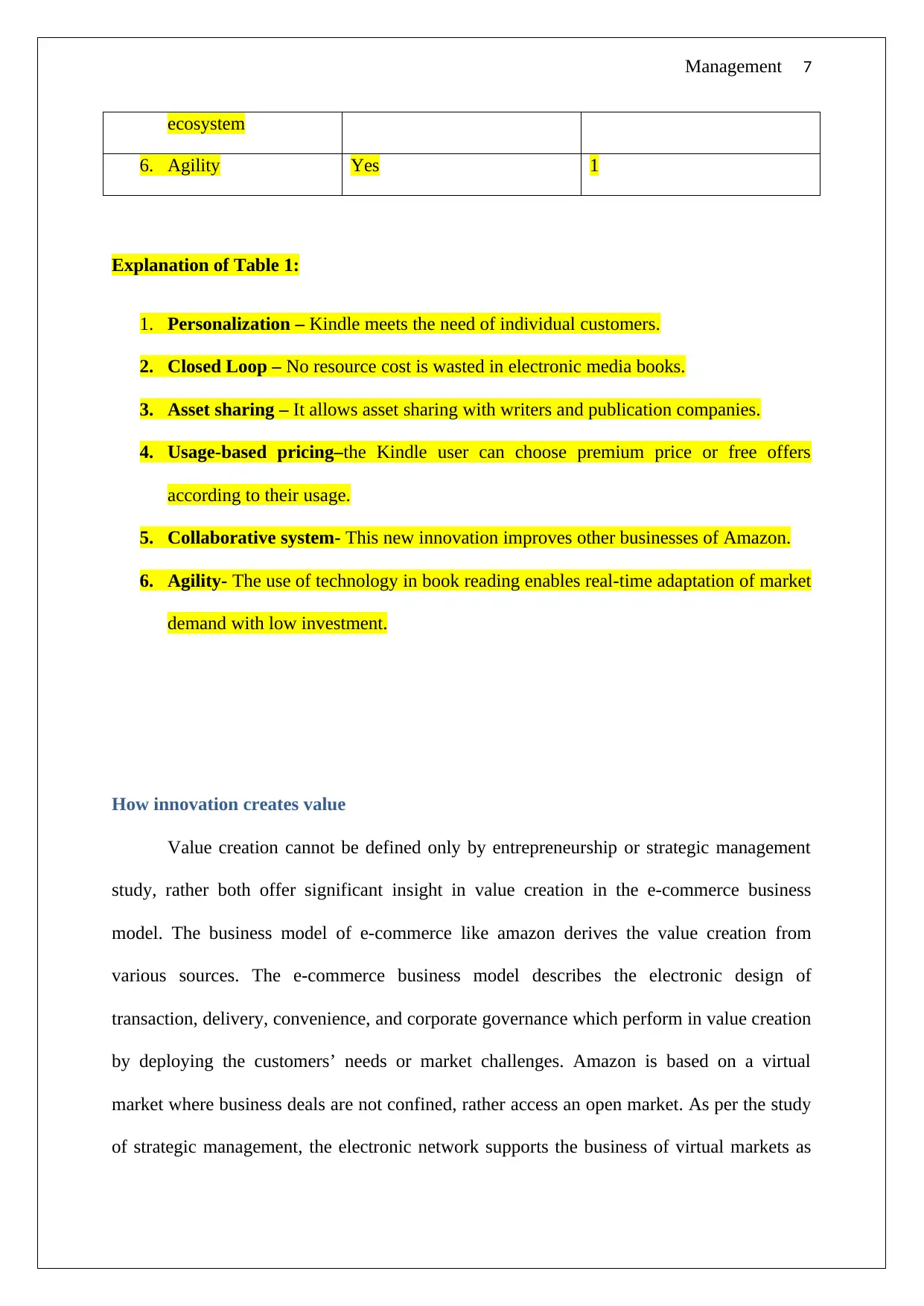
Management 7
ecosystem
6. Agility Yes 1
Explanation of Table 1:
1. Personalization – Kindle meets the need of individual customers.
2. Closed Loop – No resource cost is wasted in electronic media books.
3. Asset sharing – It allows asset sharing with writers and publication companies.
4. Usage-based pricing–the Kindle user can choose premium price or free offers
according to their usage.
5. Collaborative system- This new innovation improves other businesses of Amazon.
6. Agility- The use of technology in book reading enables real-time adaptation of market
demand with low investment.
How innovation creates value
Value creation cannot be defined only by entrepreneurship or strategic management
study, rather both offer significant insight in value creation in the e-commerce business
model. The business model of e-commerce like amazon derives the value creation from
various sources. The e-commerce business model describes the electronic design of
transaction, delivery, convenience, and corporate governance which perform in value creation
by deploying the customers’ needs or market challenges. Amazon is based on a virtual
market where business deals are not confined, rather access an open market. As per the study
of strategic management, the electronic network supports the business of virtual markets as
ecosystem
6. Agility Yes 1
Explanation of Table 1:
1. Personalization – Kindle meets the need of individual customers.
2. Closed Loop – No resource cost is wasted in electronic media books.
3. Asset sharing – It allows asset sharing with writers and publication companies.
4. Usage-based pricing–the Kindle user can choose premium price or free offers
according to their usage.
5. Collaborative system- This new innovation improves other businesses of Amazon.
6. Agility- The use of technology in book reading enables real-time adaptation of market
demand with low investment.
How innovation creates value
Value creation cannot be defined only by entrepreneurship or strategic management
study, rather both offer significant insight in value creation in the e-commerce business
model. The business model of e-commerce like amazon derives the value creation from
various sources. The e-commerce business model describes the electronic design of
transaction, delivery, convenience, and corporate governance which perform in value creation
by deploying the customers’ needs or market challenges. Amazon is based on a virtual
market where business deals are not confined, rather access an open market. As per the study
of strategic management, the electronic network supports the business of virtual markets as
Paraphrase This Document
Need a fresh take? Get an instant paraphrase of this document with our AI Paraphraser
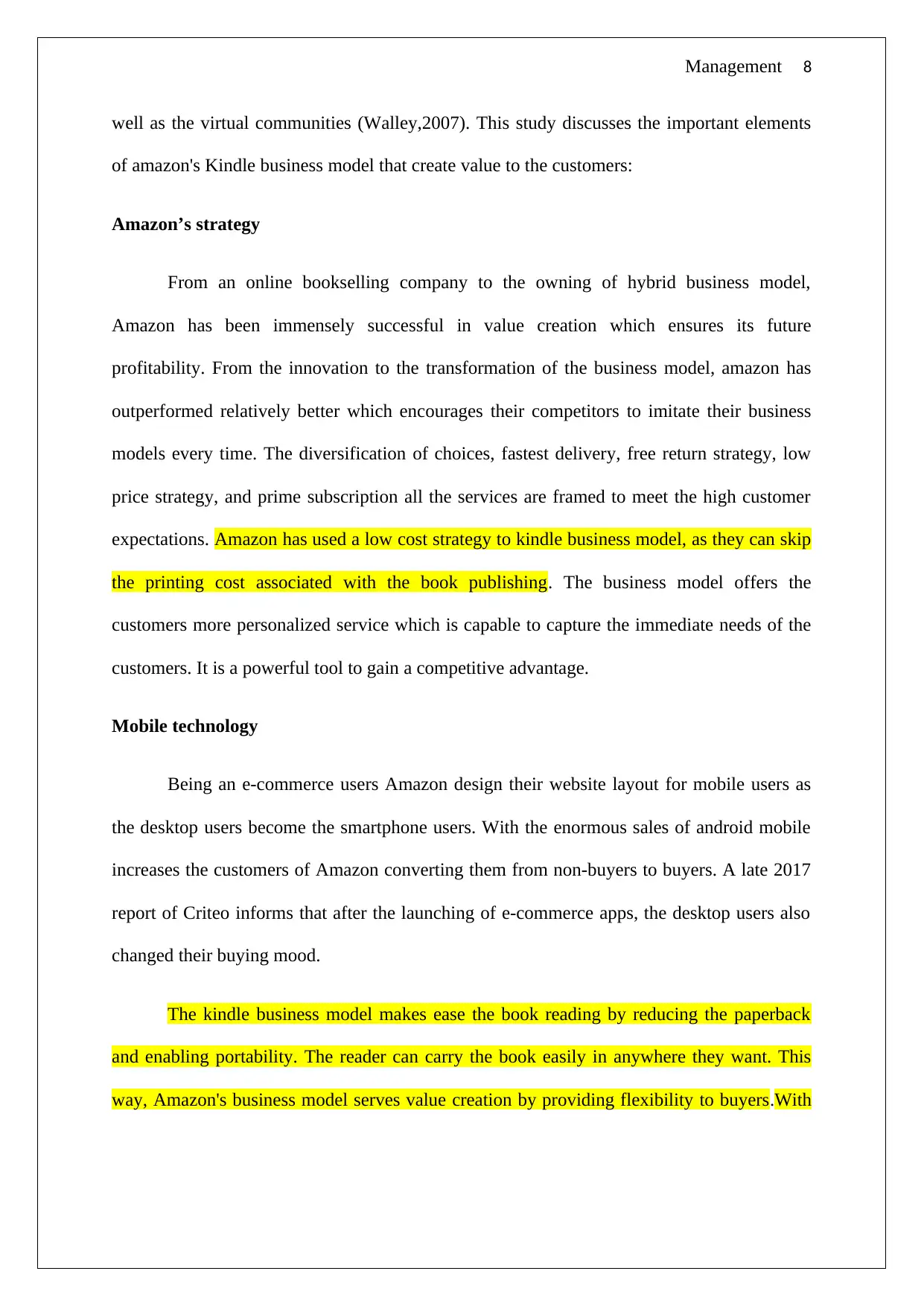
Management 8
well as the virtual communities (Walley,2007). This study discusses the important elements
of amazon's Kindle business model that create value to the customers:
Amazon’s strategy
From an online bookselling company to the owning of hybrid business model,
Amazon has been immensely successful in value creation which ensures its future
profitability. From the innovation to the transformation of the business model, amazon has
outperformed relatively better which encourages their competitors to imitate their business
models every time. The diversification of choices, fastest delivery, free return strategy, low
price strategy, and prime subscription all the services are framed to meet the high customer
expectations. Amazon has used a low cost strategy to kindle business model, as they can skip
the printing cost associated with the book publishing. The business model offers the
customers more personalized service which is capable to capture the immediate needs of the
customers. It is a powerful tool to gain a competitive advantage.
Mobile technology
Being an e-commerce users Amazon design their website layout for mobile users as
the desktop users become the smartphone users. With the enormous sales of android mobile
increases the customers of Amazon converting them from non-buyers to buyers. A late 2017
report of Criteo informs that after the launching of e-commerce apps, the desktop users also
changed their buying mood.
The kindle business model makes ease the book reading by reducing the paperback
and enabling portability. The reader can carry the book easily in anywhere they want. This
way, Amazon's business model serves value creation by providing flexibility to buyers.With
well as the virtual communities (Walley,2007). This study discusses the important elements
of amazon's Kindle business model that create value to the customers:
Amazon’s strategy
From an online bookselling company to the owning of hybrid business model,
Amazon has been immensely successful in value creation which ensures its future
profitability. From the innovation to the transformation of the business model, amazon has
outperformed relatively better which encourages their competitors to imitate their business
models every time. The diversification of choices, fastest delivery, free return strategy, low
price strategy, and prime subscription all the services are framed to meet the high customer
expectations. Amazon has used a low cost strategy to kindle business model, as they can skip
the printing cost associated with the book publishing. The business model offers the
customers more personalized service which is capable to capture the immediate needs of the
customers. It is a powerful tool to gain a competitive advantage.
Mobile technology
Being an e-commerce users Amazon design their website layout for mobile users as
the desktop users become the smartphone users. With the enormous sales of android mobile
increases the customers of Amazon converting them from non-buyers to buyers. A late 2017
report of Criteo informs that after the launching of e-commerce apps, the desktop users also
changed their buying mood.
The kindle business model makes ease the book reading by reducing the paperback
and enabling portability. The reader can carry the book easily in anywhere they want. This
way, Amazon's business model serves value creation by providing flexibility to buyers.With
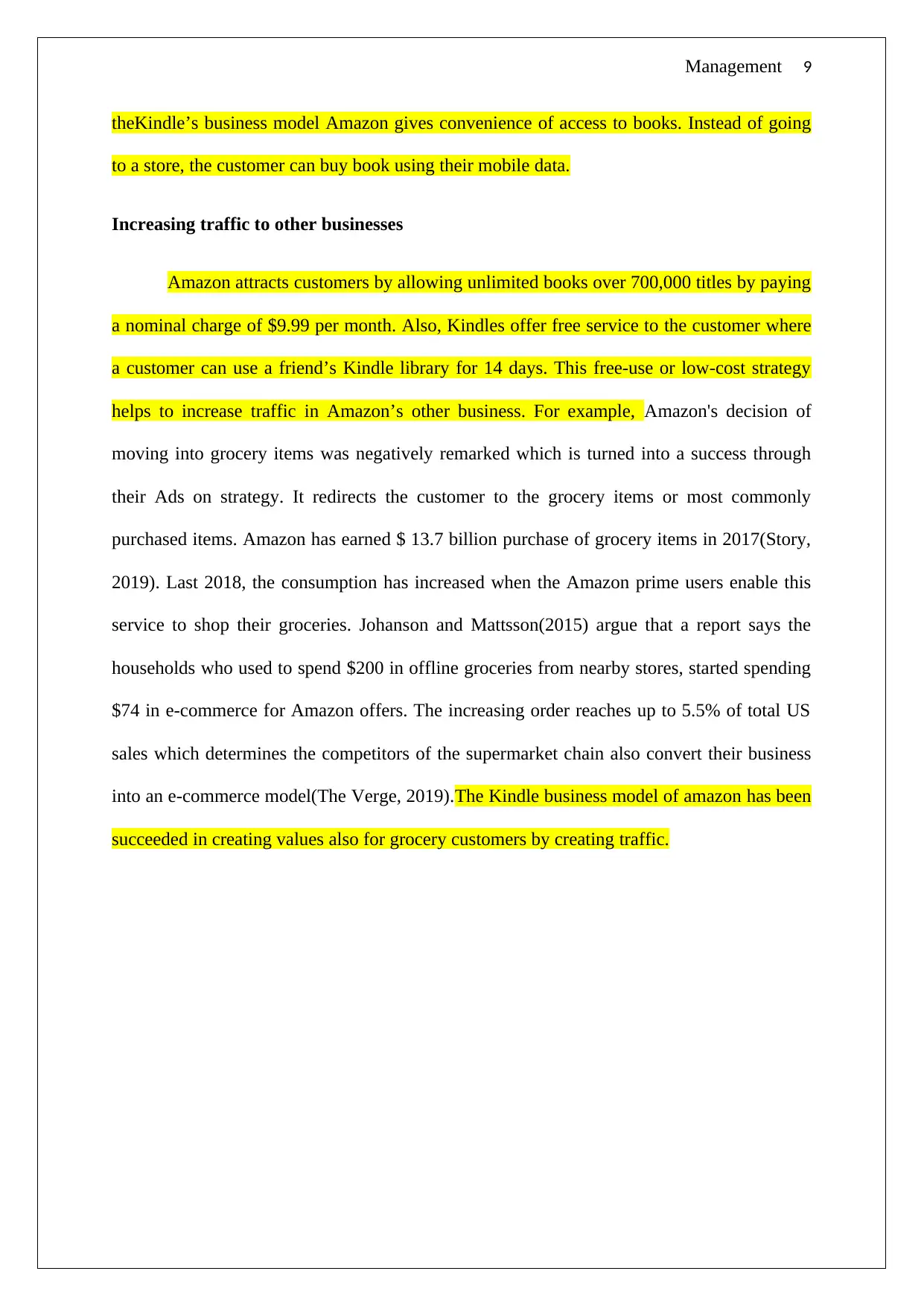
Management 9
theKindle’s business model Amazon gives convenience of access to books. Instead of going
to a store, the customer can buy book using their mobile data.
Increasing traffic to other businesses
Amazon attracts customers by allowing unlimited books over 700,000 titles by paying
a nominal charge of $9.99 per month. Also, Kindles offer free service to the customer where
a customer can use a friend’s Kindle library for 14 days. This free-use or low-cost strategy
helps to increase traffic in Amazon’s other business. For example, Amazon's decision of
moving into grocery items was negatively remarked which is turned into a success through
their Ads on strategy. It redirects the customer to the grocery items or most commonly
purchased items. Amazon has earned $ 13.7 billion purchase of grocery items in 2017(Story,
2019). Last 2018, the consumption has increased when the Amazon prime users enable this
service to shop their groceries. Johanson and Mattsson(2015) argue that a report says the
households who used to spend $200 in offline groceries from nearby stores, started spending
$74 in e-commerce for Amazon offers. The increasing order reaches up to 5.5% of total US
sales which determines the competitors of the supermarket chain also convert their business
into an e-commerce model(The Verge, 2019).The Kindle business model of amazon has been
succeeded in creating values also for grocery customers by creating traffic.
theKindle’s business model Amazon gives convenience of access to books. Instead of going
to a store, the customer can buy book using their mobile data.
Increasing traffic to other businesses
Amazon attracts customers by allowing unlimited books over 700,000 titles by paying
a nominal charge of $9.99 per month. Also, Kindles offer free service to the customer where
a customer can use a friend’s Kindle library for 14 days. This free-use or low-cost strategy
helps to increase traffic in Amazon’s other business. For example, Amazon's decision of
moving into grocery items was negatively remarked which is turned into a success through
their Ads on strategy. It redirects the customer to the grocery items or most commonly
purchased items. Amazon has earned $ 13.7 billion purchase of grocery items in 2017(Story,
2019). Last 2018, the consumption has increased when the Amazon prime users enable this
service to shop their groceries. Johanson and Mattsson(2015) argue that a report says the
households who used to spend $200 in offline groceries from nearby stores, started spending
$74 in e-commerce for Amazon offers. The increasing order reaches up to 5.5% of total US
sales which determines the competitors of the supermarket chain also convert their business
into an e-commerce model(The Verge, 2019).The Kindle business model of amazon has been
succeeded in creating values also for grocery customers by creating traffic.
⊘ This is a preview!⊘
Do you want full access?
Subscribe today to unlock all pages.

Trusted by 1+ million students worldwide
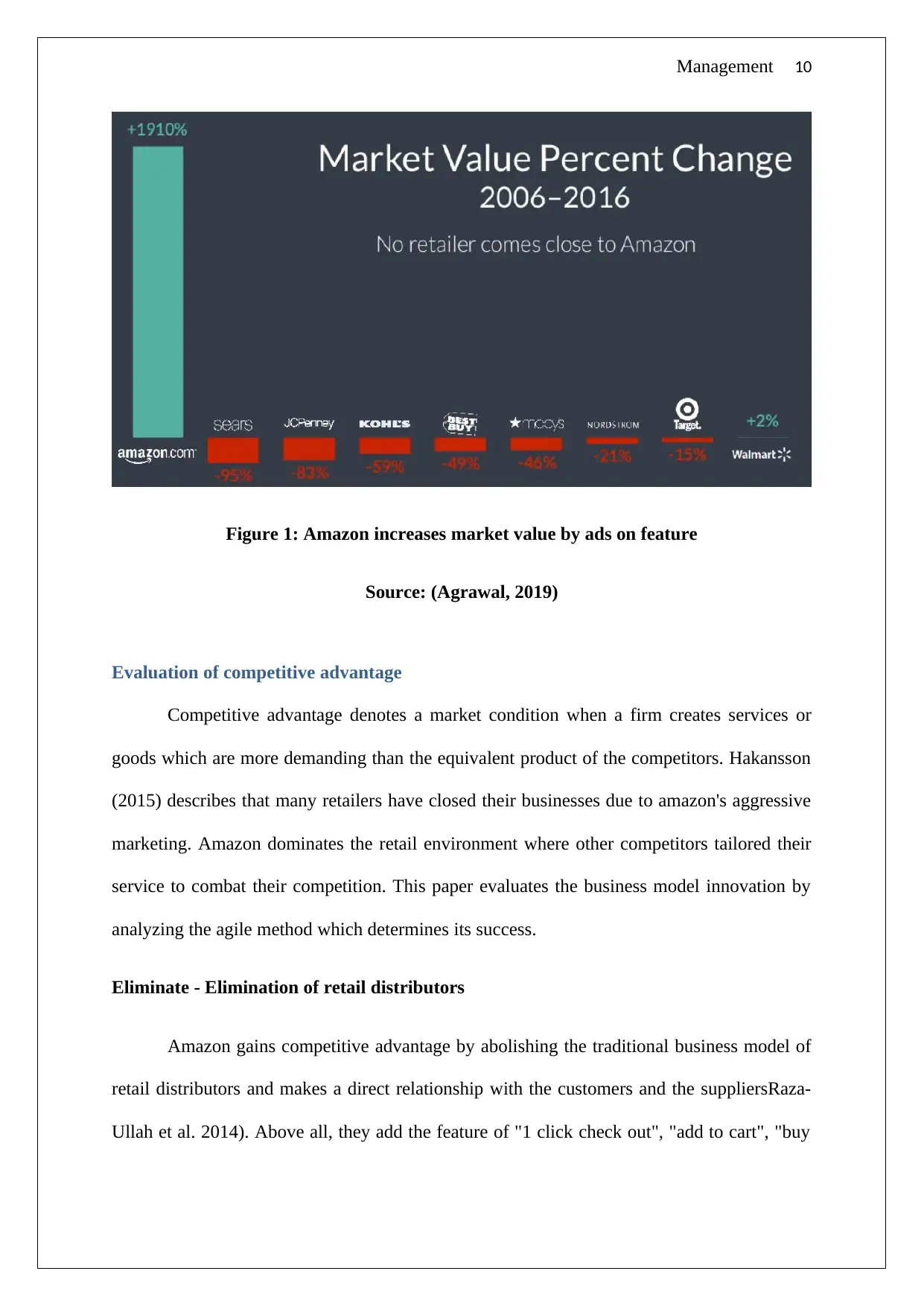
Management 10
Figure 1: Amazon increases market value by ads on feature
Source: (Agrawal, 2019)
Evaluation of competitive advantage
Competitive advantage denotes a market condition when a firm creates services or
goods which are more demanding than the equivalent product of the competitors. Hakansson
(2015) describes that many retailers have closed their businesses due to amazon's aggressive
marketing. Amazon dominates the retail environment where other competitors tailored their
service to combat their competition. This paper evaluates the business model innovation by
analyzing the agile method which determines its success.
Eliminate - Elimination of retail distributors
Amazon gains competitive advantage by abolishing the traditional business model of
retail distributors and makes a direct relationship with the customers and the suppliersRaza-
Ullah et al. 2014). Above all, they add the feature of "1 click check out", "add to cart", "buy
Figure 1: Amazon increases market value by ads on feature
Source: (Agrawal, 2019)
Evaluation of competitive advantage
Competitive advantage denotes a market condition when a firm creates services or
goods which are more demanding than the equivalent product of the competitors. Hakansson
(2015) describes that many retailers have closed their businesses due to amazon's aggressive
marketing. Amazon dominates the retail environment where other competitors tailored their
service to combat their competition. This paper evaluates the business model innovation by
analyzing the agile method which determines its success.
Eliminate - Elimination of retail distributors
Amazon gains competitive advantage by abolishing the traditional business model of
retail distributors and makes a direct relationship with the customers and the suppliersRaza-
Ullah et al. 2014). Above all, they add the feature of "1 click check out", "add to cart", "buy
Paraphrase This Document
Need a fresh take? Get an instant paraphrase of this document with our AI Paraphraser
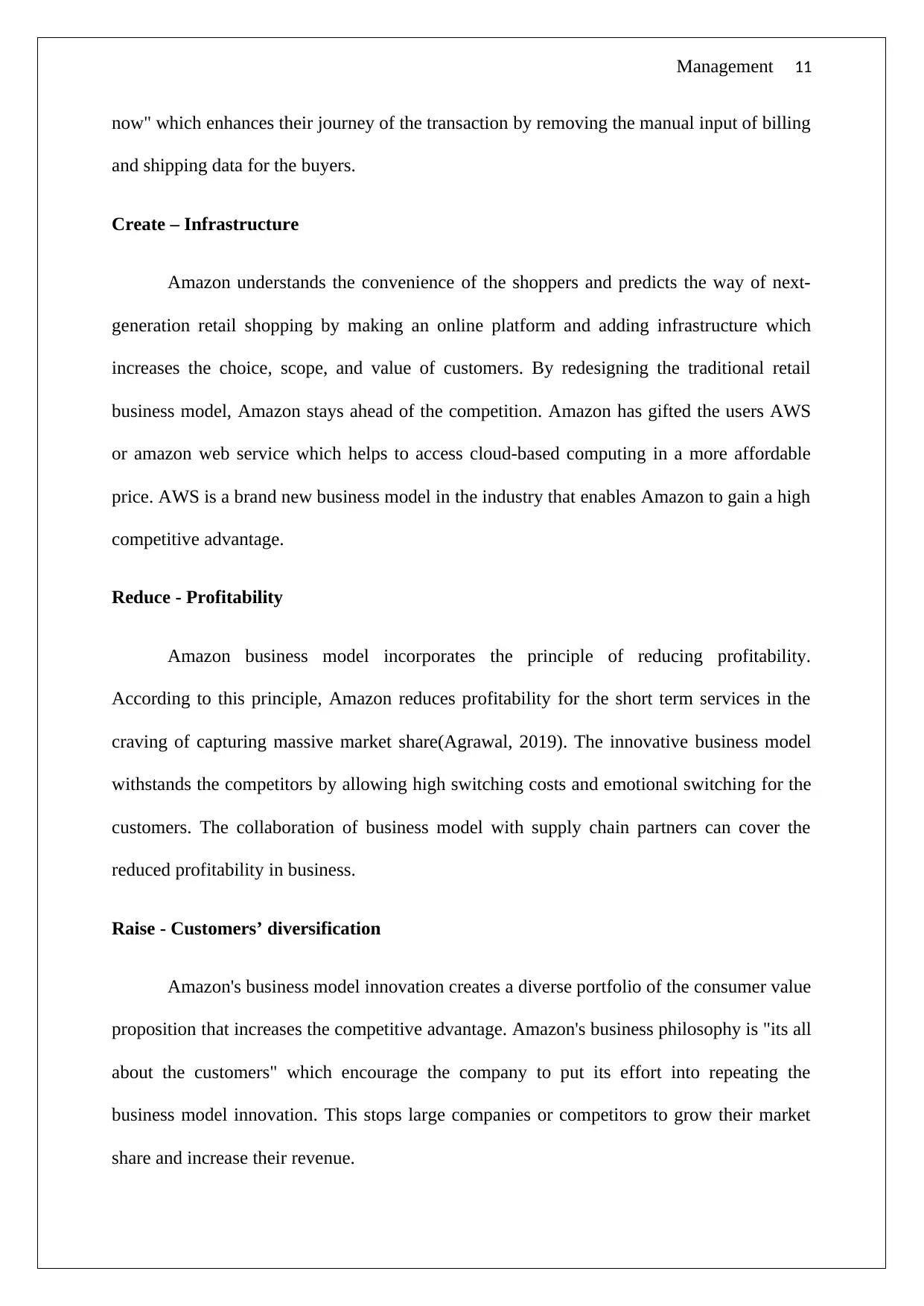
Management 11
now" which enhances their journey of the transaction by removing the manual input of billing
and shipping data for the buyers.
Create – Infrastructure
Amazon understands the convenience of the shoppers and predicts the way of next-
generation retail shopping by making an online platform and adding infrastructure which
increases the choice, scope, and value of customers. By redesigning the traditional retail
business model, Amazon stays ahead of the competition. Amazon has gifted the users AWS
or amazon web service which helps to access cloud-based computing in a more affordable
price. AWS is a brand new business model in the industry that enables Amazon to gain a high
competitive advantage.
Reduce - Profitability
Amazon business model incorporates the principle of reducing profitability.
According to this principle, Amazon reduces profitability for the short term services in the
craving of capturing massive market share(Agrawal, 2019). The innovative business model
withstands the competitors by allowing high switching costs and emotional switching for the
customers. The collaboration of business model with supply chain partners can cover the
reduced profitability in business.
Raise - Customers’ diversification
Amazon's business model innovation creates a diverse portfolio of the consumer value
proposition that increases the competitive advantage. Amazon's business philosophy is "its all
about the customers" which encourage the company to put its effort into repeating the
business model innovation. This stops large companies or competitors to grow their market
share and increase their revenue.
now" which enhances their journey of the transaction by removing the manual input of billing
and shipping data for the buyers.
Create – Infrastructure
Amazon understands the convenience of the shoppers and predicts the way of next-
generation retail shopping by making an online platform and adding infrastructure which
increases the choice, scope, and value of customers. By redesigning the traditional retail
business model, Amazon stays ahead of the competition. Amazon has gifted the users AWS
or amazon web service which helps to access cloud-based computing in a more affordable
price. AWS is a brand new business model in the industry that enables Amazon to gain a high
competitive advantage.
Reduce - Profitability
Amazon business model incorporates the principle of reducing profitability.
According to this principle, Amazon reduces profitability for the short term services in the
craving of capturing massive market share(Agrawal, 2019). The innovative business model
withstands the competitors by allowing high switching costs and emotional switching for the
customers. The collaboration of business model with supply chain partners can cover the
reduced profitability in business.
Raise - Customers’ diversification
Amazon's business model innovation creates a diverse portfolio of the consumer value
proposition that increases the competitive advantage. Amazon's business philosophy is "its all
about the customers" which encourage the company to put its effort into repeating the
business model innovation. This stops large companies or competitors to grow their market
share and increase their revenue.
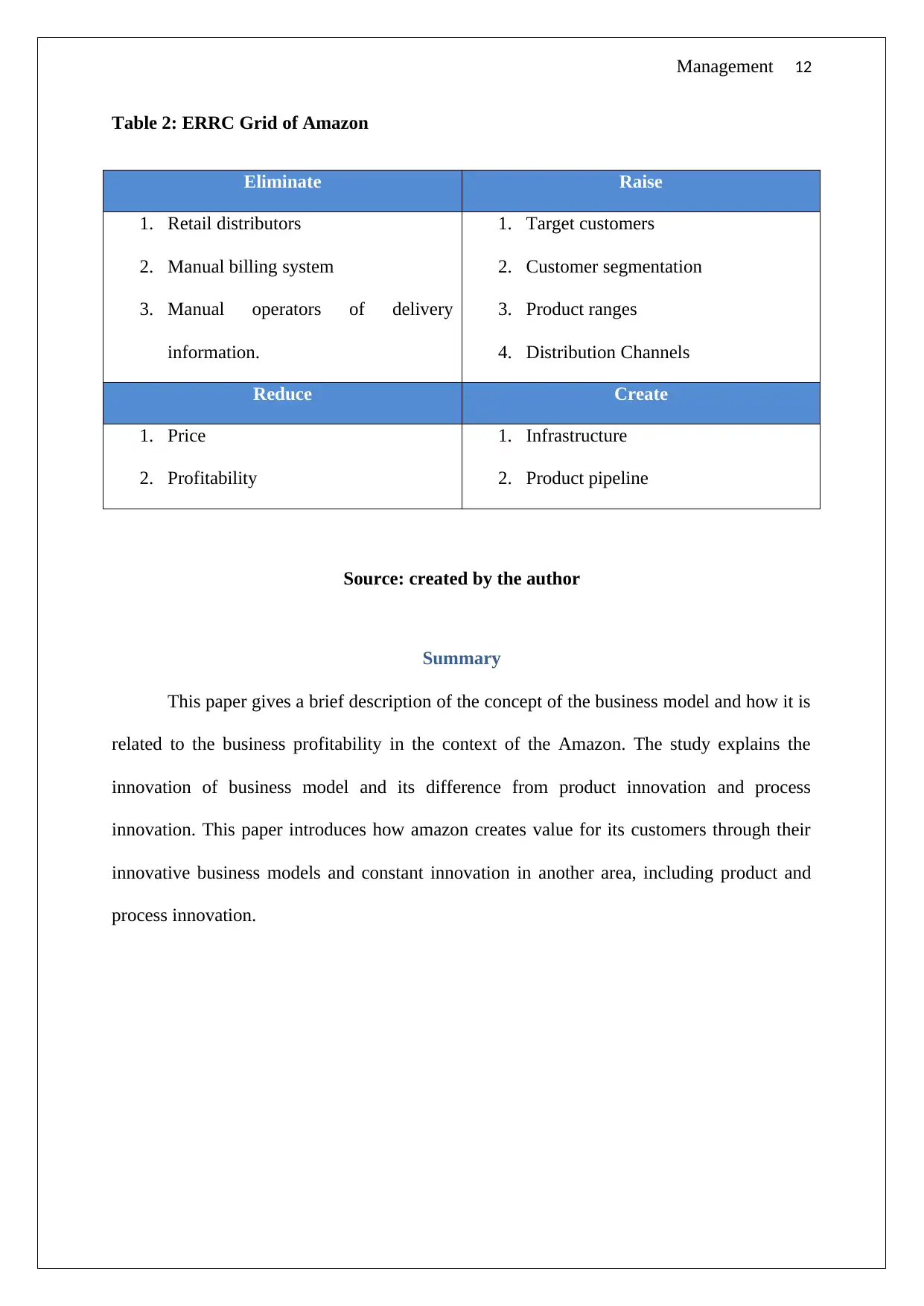
Management 12
Table 2: ERRC Grid of Amazon
Eliminate Raise
1. Retail distributors
2. Manual billing system
3. Manual operators of delivery
information.
1. Target customers
2. Customer segmentation
3. Product ranges
4. Distribution Channels
Reduce Create
1. Price
2. Profitability
1. Infrastructure
2. Product pipeline
Source: created by the author
Summary
This paper gives a brief description of the concept of the business model and how it is
related to the business profitability in the context of the Amazon. The study explains the
innovation of business model and its difference from product innovation and process
innovation. This paper introduces how amazon creates value for its customers through their
innovative business models and constant innovation in another area, including product and
process innovation.
Table 2: ERRC Grid of Amazon
Eliminate Raise
1. Retail distributors
2. Manual billing system
3. Manual operators of delivery
information.
1. Target customers
2. Customer segmentation
3. Product ranges
4. Distribution Channels
Reduce Create
1. Price
2. Profitability
1. Infrastructure
2. Product pipeline
Source: created by the author
Summary
This paper gives a brief description of the concept of the business model and how it is
related to the business profitability in the context of the Amazon. The study explains the
innovation of business model and its difference from product innovation and process
innovation. This paper introduces how amazon creates value for its customers through their
innovative business models and constant innovation in another area, including product and
process innovation.
⊘ This is a preview!⊘
Do you want full access?
Subscribe today to unlock all pages.

Trusted by 1+ million students worldwide
1 out of 14
Related Documents
Your All-in-One AI-Powered Toolkit for Academic Success.
+13062052269
info@desklib.com
Available 24*7 on WhatsApp / Email
![[object Object]](/_next/static/media/star-bottom.7253800d.svg)
Unlock your academic potential
Copyright © 2020–2025 A2Z Services. All Rights Reserved. Developed and managed by ZUCOL.


